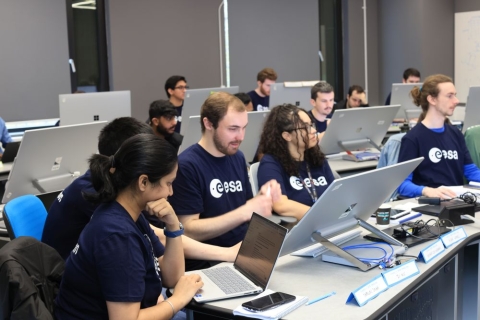

20 students took part in the European Space Agency's Concurrent Engineering Challenge
8 May 2024
5 min read
Students from the universities of Portsmouth and Surrey designed a space mission to Venus during a five-day European Space Agency Challenge, which took place in April.
The Concurrent Engineering Challenge 2024 tasked Master’s and PhD students to design a space mission using a concurrent engineering approach, which unites a multidisciplinary team to work together in the same room, at the same time.
The 20 students were from a number of subject areas, including physics, astrophysics and cosmology, electronic engineering, spacecraft engineering, power system management and more. They were split into two groups and each one was supervised by two system engineers.
The challenge took place in the University of Portsmouth’s Space Mission Incubator, a space mission design facility for interdisciplinary experts to work together in real time. The students collaborated remotely with ESA experts and other students across Europe.

Mission Success: Students and staff involved in the European Space Agency Challenge
Dr Lucy King, Space Projects Manager from the University’s Institute of Cosmology and Gravitation, said: “I am so proud of what the students achieved during the ESA challenge. None of them had experienced anything like the intensity of the concurrent engineering process before, and many of them were not even studying spacecraft design, yet by applying their subject knowledge and working as a team they managed to take a set of requirements and turn them into a detailed mission design for a Venus-bound spacecraft.”
The students had to design a mission to Venus, which would carry over 20 small satellites called CubeSats. After finding out about the challenge on Monday morning, they had until Friday afternoon to develop an entire mission architecture and spacecraft design, including the transfer orbit, operations, propellant, materials, power and communication protocols.
Dr King added: “The level of effort required to pull this off was exceptional, and the students’ passion and enthusiasm were a joy to witness. Seeing the students from Portsmouth and Surrey, one of our close partner institutions, bonding in person was also an incredible bonus.
“Hopefully they will stay in touch and may even find themselves working together at one of the many space companies in our region in the near future!”
I had a fantastic time working in the trajectories team! It was great working with the other teams and universities to refine our spacecraft design, and to get firsthand experience in the concurrent design process.
William Rogers, University of Portsmouth Physics student
Dr Becky Canning, Deputy Director (Space), at the University’s Institute of Cosmology and Gravitation, said: “The experience has been formative for our students, the concurrent manner of working was both incredibly efficient with many members of the team accelerating their satellite subsystem knowledge from scratch through to a fully-fledged design, but it also enabled the students to build their teamwork and leadership skills; each taking leadership in a particular subsystem but operating effectively as a whole."
William Rogers, a University of Portsmouth Master’s student studying Physics, said: "I had a fantastic time working in the trajectories team! It was great working with the other teams and universities to refine our spacecraft design, and to get firsthand experience in the concurrent design process."
Atif Niaz, a Master’s student in Electronic Engineering from the University of Surrey, said: “The challenge was unlike something I have ever experienced. It will remain in my memory for a very long time.”
You might also like...
Portsmouth astronomy project is nominated for ‘See Differently’ award
A University of Portsmouth project has been shortlisted for a Royal National Institute of Blind People (RNIB) See Differently Award in recognition of its groundbreaking work to make astronomy more accessible to children with a visual impairment.
24 April 2024
4 min read

Researchers enable detection of remarkable gravitational-wave signal
5 April 2024
4 minutes

UK Space Agency funding boost for Moon-orbiting satellite
The University of Portsmouth has received a funding boost from the UK Space Agency, after the success of a pilot project to develop a space mission that will place a small satellite in orbit around the Moon.
5 April 2024
5 min read

